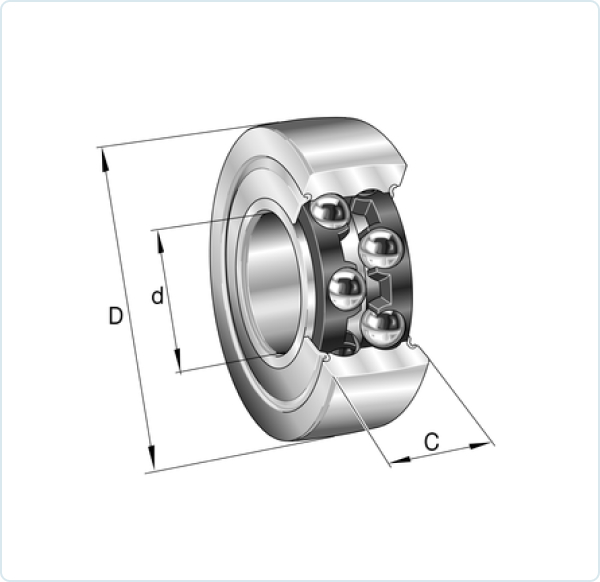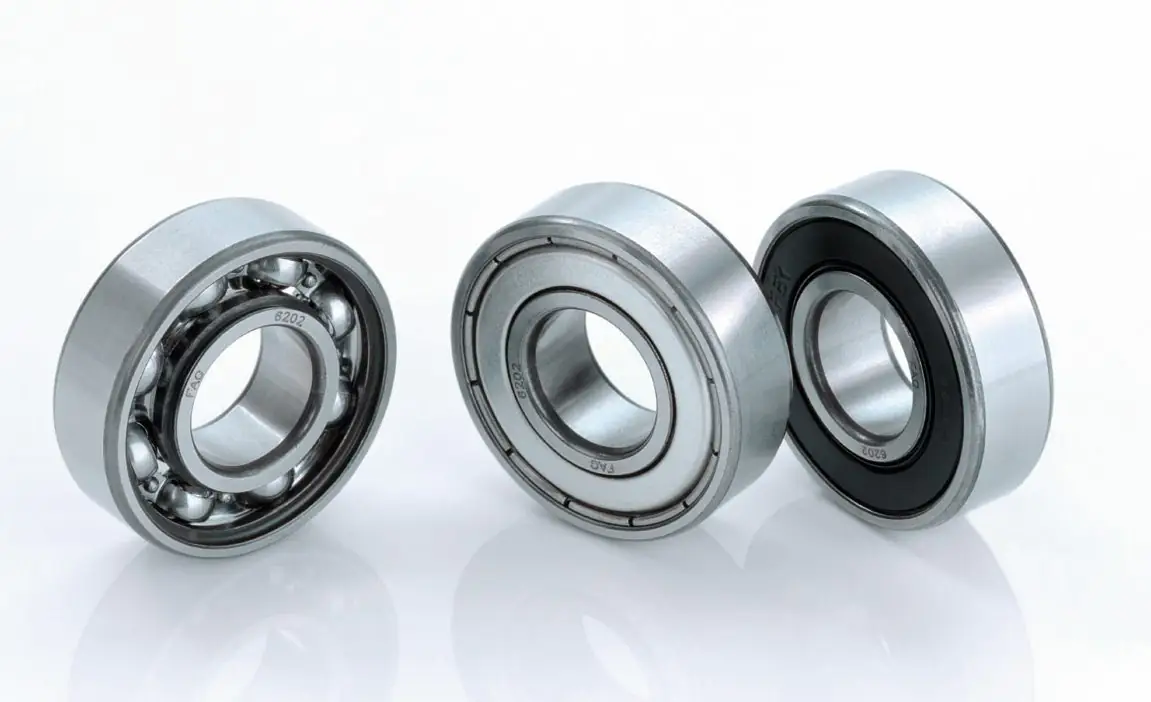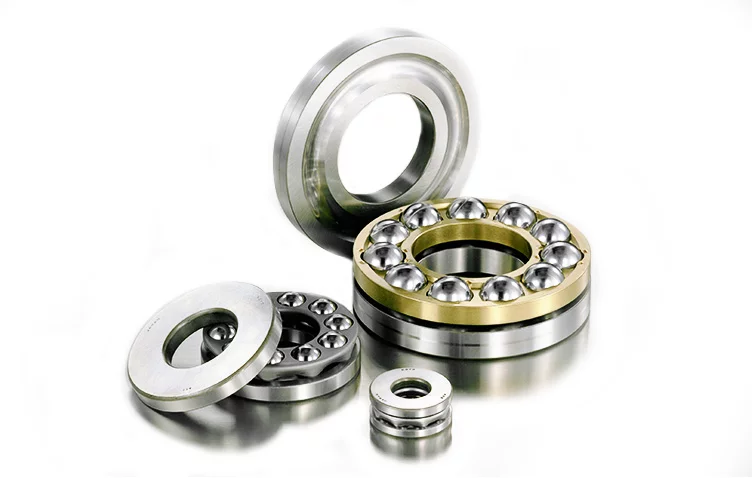
Deep groove ball bearings uses and applications
Deep groove ball bearings

Deep groove ball bearings are the most common type of bearings used. DGBB has both high radial and axial load capacities as well as high speed capabilities.
Both outer and inner rings have grooves with a radius only slightly exceeding the ball radius. Due to the curvature ratio, the bearing is capable of supporting radial and axial forces.
When the balls are loaded in this typical non loading slot type of deep groove ball bearing the bearing rings are displaced relative to each other in an eccentric positioning.
The free space is filled with balls whose size and number are so calculated that by utilizing the elasticity of the rings the balls are forced in between the rings evenly.
As you can see in the example the balls are then surrounded by a retainer.
Most frequently, two-piece stamped sheet steel cages are inserted from both sides and then joined together. Of course, there are many other types of cages where machined cages or polyamide may be used for each type of application requirement.
Deep groove ball bearings applications
Deep groove ball bearings are used in a myriad of applications. Due to its ability to sustain forces in both the radial and axial directions, its low friction and its suitability for high speeds the potential uses are endless.
Applications include:
- Electric motors automobiles
- Windmills
- Power tools
- Engines
- Gearboxes
- Medical devices
- Office machinery
- Flying cars, robots
Conrad Type ball bearings

There are deep groove ball bearings with filling slots ( also known as Conrad type) which is a predecessor to the more widely used deep groove ball bearing without filling slots.
The primary difference between the two is that the filling slot allows for the addition of one more ball increasing the load carrying capacity. While the deep groove ball bearing with filling slot is better for increasing the radial load capacity it suffers somewhat for carrying axial loads. Since nearly all bearing applications involve axial loads, the deep groove radial ball bearing without filling slots has largely replaced the former deep groove radial ball bearing with filling slots.
Further in the article, you will learn about Single row and Double row angular contact ball bearings.
Single row angular contact ball bearing

In single row angular contact ball bearing, the raceways are so arranged that the forces are transmitted from one raceway to the other under certain a certain contact angle. The angle between the line of action of the force and the radial plane. Angular contact bearings can be manufactured using 15, 18,25,30, 40 and 60 degrees depending upon the application requirements.
This example of an angular contact bearing has a brass cage. The likely application for this type of standard grade bearing is agricultural pumps.
This is an example of a high-speed angular contact bearing with a 15 degree contact angle and would likely be used in high-speed machine spindles. High-speed machining is usually associated with any spindle speed above 15k rpm.
Double row angular contact ball bearing
Double row angular contact ball bearings are of a design where two rows are running parallel in two different raceways in both the outer and inner rings. The design actually corresponds to a ready to mount pair of single row angular contact ball bearings in O-arrangement.

Double row angular contact ball bearings are capable of sustaining large radial and axial forces. They are particularly suitable for applications demanding rigid axial guidance. Generally, each ball set has a pressed steel sheet waved ribbon cage.
This is a track roller bearing with which demonstrates a typical double row combination.
Track rollers – also referred to as idler rollers – are motion transmission components designed to work with all varieties of tracks. They see use in conveyor systems, cam drives, and a wide range of similar material handling systems.
These are just a few examples of the way deep groove ball bearings are applied. In addition to those bearings described here, single row angular contact bearings can be paired, used in threes, or even four or five together to achieve the goals required.
Another category is self aligning bearings.
Self aligning bearings
In the self aligning ball bearing the raceway of the outer ring is spherical while the inner ring has two grooved raceways. The cage combines the two balls sets and the inner ring to form a unit that can align itself with the outer ring. The bearing is therefore not affected by misalignment of shaft and housing nor by shaft deflections.
These bearings are primarily used in agricultural machinery, conveyors, line shafting, woodworking machines etc.
What is the application of single row deep groove ball bearing?
Single row deep groove ball bearings are among the most widely used types of bearings due to their versatility, simplicity in design, and cost-effectiveness. These bearings are characterized by their deep raceways and the ability to bear radial as well as moderate axial loads from both directions. They are designed with a single row of balls, making them a straightforward and a highly efficient bearing solution. The applications of single row deep groove ball bearings span across various industries and machinery, due to their distinctive features and benefits.
General Machinery and Electric Motors
One of the most common applications for single row deep groove ball bearings is in electric motors and general machinery. Their ability to handle moderate speeds and provide quiet and efficient operation makes them ideal for these applications. They are often found in household appliances, power tools, fans, and other small to medium-sized electric motors.
Automotive Industry
In the automotive sector, single row deep groove ball bearings are used in various components such as alternators, starters, clutches, and transmissions. Their robustness and reliability under varying operational conditions make them suitable for automotive applications.
Industrial Gearboxes
Gearboxes, which require precise and efficient rotation, often employ single row deep groove ball bearings. Their ability to handle both radial and axial loads efficiently while maintaining low friction is advantageous in these applications.
Pumps and Compressors
Pumps and compressors, which are essential components in many industrial processes, also utilize these bearings. They are chosen for their capacity to operate reliably under high radial loads and at varying speed conditions.
Agricultural Machinery
In the agricultural sector, equipment like tractors, combines, and other machinery often incorporate single row deep groove ball bearings due to their durability and ability to operate effectively in environments with dust and moisture.
Material Handling Systems
Conveyor systems and other material handling equipment rely on these bearings for smooth operation. Their ability to support radial loads and handle moderate axial loads is essential in the smooth and efficient movement of materials.
Precision Instruments
In precision applications, such as in medical equipment or high-speed machinery, single row deep groove ball bearings are valued for their running accuracy and low noise levels.
Recreational Applications
They are also used in recreational applications like skateboards, inline skates, and bicycles, where their compactness and efficiency in handling both radial and axial loads are crucial.
If you still have questions or need further discussion on any topic, don’t hesitate to reach out to us. Our team at PIB Sales is dedicated to providing you with the assistance and information you need. Whether it’s detailed data about our products, a specific technical question, or if you require guidance in choosing the right solution for your needs, we are here to help. Contact PIB Sales today, and let’s ensure you have all the information and support you need for your decisions.









 Short Rigid Couplings
Short Rigid Couplings Controlflex Couplings
Controlflex Couplings Jaw Couplings
Jaw Couplings Oldham Couplings
Oldham Couplings Bearing Locknuts – TCN
Bearing Locknuts – TCN Double Wide Shaft Collars
Double Wide Shaft Collars Heavy Duty Shaft Collars
Heavy Duty Shaft Collars International Series Shaft Collars
International Series Shaft Collars Keyed Shaft Collars
Keyed Shaft Collars Mountable Shaft Collars
Mountable Shaft Collars Quick Clamping Shaft Collars
Quick Clamping Shaft Collars Set Screw Shaft Collars
Set Screw Shaft Collars Thin Line Shaft Collars
Thin Line Shaft Collars Threaded Shaft Collars – Pacific International Bearing Products
Threaded Shaft Collars – Pacific International Bearing Products Two-Piece Shaft Collars
Two-Piece Shaft Collars Friction Bearing Universal Joints
Friction Bearing Universal Joints Needle Bearing Universal Joints
Needle Bearing Universal Joints

